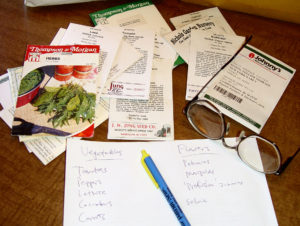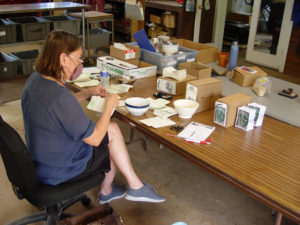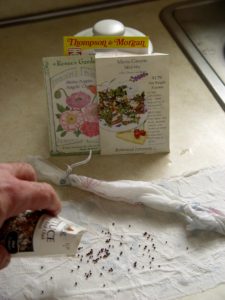It’s Not Too Soon to Think About Seeds
November 30th, 2021
You might be in Christmas mode this time of year, but it’s not a bad idea to be thinking about ordering seeds for your 2022 garden already, too.

Your fellow gardeners are ordering seeds earlier than ever. You might need to step up your time frame to avoid sellouts.
For a second year in a row this year, seed companies faced a double whammy of COVID-related, order-filling handicaps and another extra-heavy spike in seed demand.
The result was that gardeners who waited until March or even February to order seeds ran into weeks-long shipment delays, sellouts of popular varieties, and in some cases, complete (although temporary) ordering shutdowns.
Part of the early-season backlogs came because gardeners knew what happened the year before and got their 2021 orders in right off the bat in January.
Johnny’s Selected Seeds CEO David Mehlhorn said peak seed-buying season is usually mid-February through mid-April, but this year the rush began weeks sooner.
If you want to stay ahead of even the early-birds and have your best chance of getting the varieties you want, now isn’t too soon to make your move.
Seed companies have their lists online already (for the most part) and are taking orders much earlier than the days when paper seed catalogs went out soon after Christmas, and gardeners did most of their ordering in late winter.
Seed companies said there wasn’t (and isn’t) really a “seed shortage.” Rather the problems have been more related to bottlenecks in getting seed from the growers and into gardeners’ hands.
One problem has been COVID-related trucking and shipping backlogs, which has affected a lot of industries. Much of the seed sold for American gardens is grown in and imported from Asia and South and Central America.

Seed packets at small companies are still filled by hand.
Even when the bulk seed gets to the seed houses, labor shortages have hampered companies’ ability to divvy up the seed into individual packets. While the bigger seed houses pack with machinery, smaller companies pack by hand.
Then there’s been the back-end slow-downs of filling orders, getting them out the door, and coping with slower delivery times.
Add all of that to seed demand that was up another one-third to one-half this year and it’s no wonder store racks got picked over and catalog companies ran into more sellouts than usual.
Things got so crazy by February that companies such as Johnny’s Selected Seeds and Fedco resorted to wait lists and daily quotas, while Baker Creek Heirloom Seeds shut off ordering altogether.
That may not be the scenario again this seed-buying season, but seed-sellers are advising gardeners to order/buy ASAP, be patient, and be willing to substitute for out-of-stock favorites.
If you get shut out, delayed, or find that a variety you want is already sold out, try another company. Not everyone is sold out of the same thing, and many sellouts are just temporary until companies can refill more packets from their bulk-seed bags.
Second, have a look at the seed racks at local stores and garden centers. These might not have the selection realm of catalogs, but they do give you seed in hand instantly.
Third, be willing to substitute. If your usual favorite is out of stock, try something else. You might find that you end up liking a substitute variety even better.
And fourth, snoop around for or initiate seed swaps. Friends, neighbors, and fellow gardeners might have seeds left over from too-big packets that they’re willing to share or swap for your excesses.
Online offers often pop up on social-media platforms, while some garden clubs, local groups, and even an occasional library organize swaps.
The Iowa-based Seed Savers Exchange is a national (and free) seed-swapping service that also offers tips on how to start a local seed swap.
Read National Garden Bureau’s tips on seed-buying
See a list of George’s top-10 seed and garden catalogs
Read George’s PennLive column on wise seed-shopping
Don’t assume any unused seed you have from prior years is bad, by the way. Most seeds keep for two or three years… sometimes longer, if you’ve stored it well.

Roll up seeds in a damp paper towel (inserted into a plastic bag) to check for seed viability.
The best place to save seed is inside envelopes or packets stored in a screw-on jar in the refrigerator. A packet of silica gel or dry powered milk in the jar helps absorb moisture.
Second best is any other cool, dry spot you can find. Humid spots are bad, and so are areas that get really hot in summer or seesaw between sub-freezing and above-freezing in winter.
Some seeds naturally store better than others.
Lettuce, corn, parsnips, peppers, spinach, and onions are examples of edible species on the short-lived side (a year or two).
Cucumbers, melons, and radishes are more on the long-lived side (typically four or five years).
Most of the rest are somewhere in between, i.e. tomatoes, squash, beets, eggplant, pumpkins, turnips, chard, cabbage, cauliflower, broccoli, carrots, beans, and peas.
In flowers, some of the longest-keeping species (four to five years) are ageratum, beebalm, calendula, celosia, cosmos, nicotiana, nasturtium, snapdragons, alyssum, and zinnias.
Some of the shortest keepers (a year or two) are columbine, coleus, delphinium, forget-me-nots, heliotrope, purple hyacinth beans, impatiens, larkspur, vinca, pansy, phlox, salvia, and verbena.
The rest are generally good for three or four years, if stored well.
If you’re not sure what’s still viable and what’s not, wrap a few seeds (10 is a good, round number) in a damp paper towel and place in a sealed plastic bag at a temperature ideal for germination. If the seed packet doesn’t specify ideal germination temperature, around 70 degrees is a good average for most plants.
While you’re at it, you might want to get your order in ASAP for any live plants you plan to acquire online or by mail-order this year.
Fellow gardeners are getting those orders in earlier than ever, too.







